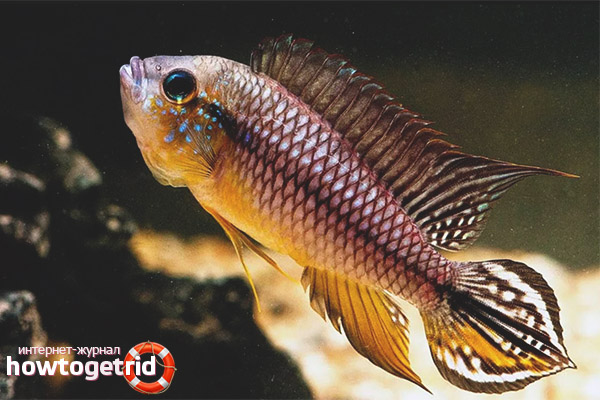The content of the article
Agassica apistograms or torchlight are beautiful, bright and compact in size fish. Depending on the places where they live, their colors may vary among themselves, and the breeders are faced with the task of constantly breeding new species and types of colors.
In addition to bright colors and small sizes - no more than 8 centimeters, they are distinguished by a peaceful disposition. Compared with other representatives of cichlids, they are just babies, it is very convenient for keeping them in a small aquarium. Nevertheless, they are rather capricious in leaving and preference is given to them by owners who do not have the opportunity to start large aquariums. The main problem is the requirement that the water be really clean. They are sensitive to ammonia and nitrates, to a sufficient level of O2 in water. When the oxygen content in the water is low, agassica can become ill and even die.
They can be called fish, which can well be kept in a common aquarium along with other relatives. They are not aggressive and have small sizes, but with very small fish they still should not be settled together.
How do they live in natural conditions?
The first mention of apistograms of agassits was recorded in the 75th year of the 19th century. They come from South America, where they live in the Amazon River. It is the habitat that they owe their spectacular color, which depends on their place of origin.
Their favorite places are where there is no strong current. Where they live, fallen leaves from tropical plants are at the bottom, and the water is quite dark in color due to the fact that these leaves secrete tannins.
Fact! Males apistorgamma agassica prone to polygamous relationships. They, as a rule, choose for themselves several females for family relationships.
Appearance
Care Features
Representatives of this breed are preferably kept by those who have experience in breeding cyclides of another species. They are small, non-aggressive, not capricious with regards to nutrition. But they are picky enough in terms of living conditions.
Nutrition
Absolutely omnivorous fish that feed on small insects and various benthic benthos. In an aquarium, they preferably eat live or frozen food: bloodworms, tubule, coronet, artemia and animal feed produced in industrial conditions.
Due to the fact that these fish are extremely demanding on the quality of water, feeding should be done several times a day, giving food in small quantities so that its remains do not remain in the water.
Conditions of detention
For living apistograms agassits most suitable aquariums up to 80 liters. It is important for them to constantly maintain conditions and clean water. It should have a pH from 5 to 7 and a temperature of about 25 degrees. Gradually, they get used to exactly the conditions in which they are, even if they are not quite comfortable. But these fish breed only in favorable conditions.
It is extremely important to control the levels of nitrates and ammonia in the water. These substances greatly affect the histograms of agassits. Regularly siphon the bottom and keep the water clean.The complexity of the content lies in the fact that agassits are extremely susceptible to the composition of water and the presence of foreign chemical compounds in it.
Regarding the scenery, the best option are pieces of wood, pots and halves of coconut. Fish need shelters, because in natural conditions they actively use them. It is desirable that there is more vegetation in the aquarium. The bottom must be lined with small pebbles, for example, gravel or basalt. It is comfortable for agassits soil. In addition, against the background of such decor, they look very expressive and impressive.
Neighborhood with other inhabitants of the aquarium
Many owners of home fish care about whether it is possible to contain apistograms of agassits in the same environment with others. The basic rule for successful cohabitation is that they be approximately the same size. If male maintenance is planned, the aquarium should be more spacious.
Their neighbors can be small cichlids - Ramirezi apistograms, cichlids - parrots or fish who like to live in the middle and upper layers - fire barbs, rhodostomuses, zebrafish.
Gender differences
Males of agassic apistograms are large relative to females and have a brighter color. They have large and pointed fins. Females, in addition to smaller sizes, are less bright in color and have a rounded belly.
Breeding Features
For spawning, it is necessary to observe a pH of 6 and a temperature in the region of 26 degrees. Females lay 40 to 150 eggs at a time. To lay eggs, they need a shelter, which can be inverted pots, halves of coconuts or driftwood. The eggs cling to the walls of the shelter, and the female takes care of them. After three to four days, the larvae hatch from them, and after a few more days the fry begin to eat and swim.
After they begin to swim on their own, the females continue to patronize them intently. They teach their babies important skills for their future lives. You need to feed the fry with liquid feed and infusoria. When they grow up a little, they begin to feed them with microworms and naupilii artemia.
Video: aquarium fish apistogram agassitsa











Submit